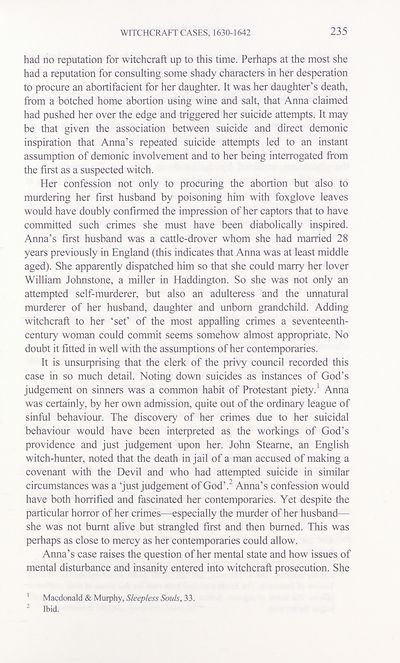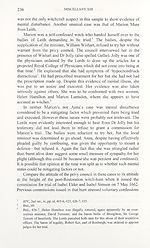Series 5 > Miscellany [of the Scottish History Society] XIII
(250) Page 235
Download files
Complete book:
Individual page:
Thumbnail gallery: Grid view | List view

WITCHCRAFT CASES, 1630-1642
235
had no reputation for witchcraft up to this time. Perhaps at the most she
had a reputation for consulting some shady characters in her desperation
to procure an abortifacient for her daughter. It was her daughter’s death,
from a botched home abortion using wine and salt, that Anna claimed
had pushed her over the edge and triggered her suicide attempts. It may
be that given the association between suicide and direct demonic
inspiration that Anna’s repeated suicide attempts led to an instant
assumption of demonic involvement and to her being interrogated from
the first as a suspected witch.
Her confession not only to procuring the abortion but also to
murdering her first husband by poisoning him with foxglove leaves
would have doubly confirmed the impression of her captors that to have
committed such crimes she must have been diabolically inspired.
Anna’s first husband was a cattle-drover whom she had married 28
years previously in England (this indicates that Anna was at least middle
aged). She apparently dispatched him so that she could marry her lover
William Johnstone, a miller in Haddington. So she was not only an
attempted self-murderer, but also an adulteress and the unnatural
murderer of her husband, daughter and unborn grandchild. Adding
witchcraft to her ‘set’ of the most appalling crimes a seventeenth-
century woman could commit seems somehow almost appropriate. No
doubt it fitted in well with the assumptions of her contemporaries.
It is unsurprising that the clerk of the privy council recorded this
case in so much detail. Noting down suicides as instances of God’s
judgement on sinners was a common habit of Protestant piety.1 Anna
was certainly, by her own admission, quite out of the ordinary league of
sinful behaviour. The discovery of her crimes due to her suicidal
behaviour would have been interpreted as the workings of God’s
providence and just judgement upon her. John Steame, an English
witch-hunter, noted that the death in jail of a man accused of making a
covenant with the Devil and who had attempted suicide in similar
circumstances was a ‘just judgement of God’.2 Anna’s confession would
have both horrified and fascinated her contemporaries. Yet despite the
particular horror of her crimes—especially the murder of her husband—
she was not burnt alive but strangled first and then burned. This was
perhaps as close to mercy as her contemporaries could allow.
Anna’s case raises the question of her mental state and how issues of
mental disturbance and insanity entered into witchcraft prosecution. She
1 Macdonald & Murphy, Sleepless Souls, 33.
2 Ibid.
235
had no reputation for witchcraft up to this time. Perhaps at the most she
had a reputation for consulting some shady characters in her desperation
to procure an abortifacient for her daughter. It was her daughter’s death,
from a botched home abortion using wine and salt, that Anna claimed
had pushed her over the edge and triggered her suicide attempts. It may
be that given the association between suicide and direct demonic
inspiration that Anna’s repeated suicide attempts led to an instant
assumption of demonic involvement and to her being interrogated from
the first as a suspected witch.
Her confession not only to procuring the abortion but also to
murdering her first husband by poisoning him with foxglove leaves
would have doubly confirmed the impression of her captors that to have
committed such crimes she must have been diabolically inspired.
Anna’s first husband was a cattle-drover whom she had married 28
years previously in England (this indicates that Anna was at least middle
aged). She apparently dispatched him so that she could marry her lover
William Johnstone, a miller in Haddington. So she was not only an
attempted self-murderer, but also an adulteress and the unnatural
murderer of her husband, daughter and unborn grandchild. Adding
witchcraft to her ‘set’ of the most appalling crimes a seventeenth-
century woman could commit seems somehow almost appropriate. No
doubt it fitted in well with the assumptions of her contemporaries.
It is unsurprising that the clerk of the privy council recorded this
case in so much detail. Noting down suicides as instances of God’s
judgement on sinners was a common habit of Protestant piety.1 Anna
was certainly, by her own admission, quite out of the ordinary league of
sinful behaviour. The discovery of her crimes due to her suicidal
behaviour would have been interpreted as the workings of God’s
providence and just judgement upon her. John Steame, an English
witch-hunter, noted that the death in jail of a man accused of making a
covenant with the Devil and who had attempted suicide in similar
circumstances was a ‘just judgement of God’.2 Anna’s confession would
have both horrified and fascinated her contemporaries. Yet despite the
particular horror of her crimes—especially the murder of her husband—
she was not burnt alive but strangled first and then burned. This was
perhaps as close to mercy as her contemporaries could allow.
Anna’s case raises the question of her mental state and how issues of
mental disturbance and insanity entered into witchcraft prosecution. She
1 Macdonald & Murphy, Sleepless Souls, 33.
2 Ibid.
Set display mode to:
![]() Universal Viewer |
Universal Viewer | ![]() Mirador |
Large image | Transcription
Mirador |
Large image | Transcription
Images and transcriptions on this page, including medium image downloads, may be used under the Creative Commons Attribution 4.0 International Licence unless otherwise stated. ![]()
| Scottish History Society volumes > Series 5 > Miscellany [of the Scottish History Society] XIII > (250) Page 235 |
|---|
| Permanent URL | https://digital.nls.uk/127316529 |
|---|
| Description | Over 180 volumes, published by the Scottish History Society, containing original sources on Scotland's history and people. With a wide range of subjects, the books collectively cover all periods from the 12th to 20th centuries, and reflect changing trends in Scottish history. Sources are accompanied by scholarly interpretation, references and bibliographies. Volumes are usually published annually, and more digitised volumes will be added as they become available. |
|---|


